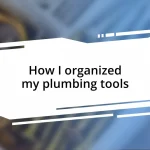Key takeaways:
- Not all toilet bowl cracks are equal; assess the severity and potential for leakage before attempting repairs.
- Gather necessary tools like a putty knife, sandpaper, epoxy, and waterproof sealant to ensure a smooth repair process.
- Thoroughly clean the cracked area before applying epoxy to enhance adhesion and avoid failures.
- Test for leaks after repairs by observing for water pooling or using paper towels; address any leaks promptly to prevent further damage.

Understanding toilet bowl cracks
Toilet bowl cracks can be surprisingly common, often stemming from wear and tear or sudden impacts. I remember the first time I noticed a crack forming in my own toilet; it almost felt like a betrayal, as if something I relied on so heavily was letting me down. Have you ever experienced that sinking feeling when you discover a problem in an everyday object?
It’s essential to understand that not all cracks are created equal. Some might just be cosmetic, while others could lead to leaks and serious water damage over time. I once neglected a small hairline crack, thinking it was innocuous, only to find myself mopping up water days later. Isn’t it fascinating how something so seemingly small can have such significant consequences?
Moreover, the age and material of your toilet can play a crucial role in whether it cracks. For instance, older porcelain toilets are more prone to cracks due to their brittleness. When I chose to replace my old toilet with a newer model, the peace of mind I gained was truly refreshing. Have you considered how the type of toilet in your home might affect your own maintenance routine?

Identifying the right repair type
Identifying the right type of repair for a cracked toilet bowl is crucial for preventing further damage. I learned this the hard way when I mistakenly applied the wrong epoxy to my toilet crack, thinking a quick fix would suffice. The result? A larger mess that needed professional help! This experience taught me the importance of assessing the crack’s severity and origin before diving into repairs.
When determining the repair method, consider the following factors:
- Crack Size: Small, hairline cracks may be fixable with sealants, while larger cracks typically require replacing the bowl.
- Location of the Crack: Cracks near the base or rim can affect stability and function, necessitating different repair strategies.
- Material Type: Porcelain may need a specialized epoxy, while ceramic could handle a standard repair kit.
- Water Leakage Risk: If the crack is leaking, immediate attention is essential to prevent water damage.
I can’t tell you how relieved I felt when I finally consulted an expert who helped me choose the right approach. That sense of relief sparked a newfound confidence in tackling repairs; it reinforced the notion that sometimes asking for guidance is the best repair method of all.

Gathering necessary repair tools
Gathering the right tools for toilet bowl repair is a vital step that shouldn’t be overlooked. I learned this the hard way during my first attempt at fixing a cracked toilet; I realized that without the appropriate tools, even the simplest repairs can turn into frustrating adventures. Can you relate to that feeling of dread when you start a project and find yourself missing something crucial? It’s like setting off on a journey without a map!
The basic tools you’ll need typically include a putty knife, sandpaper, and a good quality epoxy. Depending on the complexity of the repair, you might also require a paintbrush and a waterproof sealant. I once faced a situation where I had to drive to the hardware store multiple times to gather missing items, and it felt like my project was cursed! Planning ahead and gathering everything at once not only saves time but also keeps the momentum going when tackling repair tasks.
Lastly, don’t forget about safety gear. Plastic gloves, goggles, and even a mask can make a significant difference by protecting you from chemicals and debris. I remember a time when I skipped the goggles, thinking they were unnecessary. The aftermath? A painful reminder as I dealt with irritation in my eyes. It’s a small price to pay to ensure safety and comfort during the repair process.
| Tool | Purpose |
|---|---|
| Putty Knife | Great for removing old sealant and smoothening surfaces. |
| Sandpaper | Essential for preparing the cracked area before applying epoxy. |
| Epoxy | Main adhesive for sealing the crack effectively. |
| Waterproof Sealant | Provides extra protection against future leaks. |
| Paintbrush | Useful for applying sealant evenly. |

Step by step repair process
Once you’ve gathered your tools, it’s time to dive into the actual repair. Start by thoroughly cleaning the cracked area. I vividly remember the day mine needed fixing; I thought I could skip this part—big mistake! Residue and grime can prevent the epoxy from adhering properly, leading to a failed repair. The key here is to use a mild cleaner and ensure the surface is dry and dust-free for the best results.
Next, I mixed the epoxy according to the package instructions, which has become second nature for me now. Make sure to wear gloves, as this stuff can be sticky and a bit unforgiving! I still chuckle about the time I forgot gloves and ended up with epoxy all over my hands. After stirring, I applied the mixture generously over the crack using my putty knife. It’s crucial to get into all those tiny crevices; I’ve learned that thin layers won’t suffice.
Finally, give the epoxy enough time to cure, typically around 24 hours for most products. Patience is key here. I used to rush this step, thinking I could just jump back into the daily grind, but trust me, it’s worth allowing the repair to set undisturbed. To prevent any anxiety about the repair’s effectiveness, I often visualize the fixed bowl as I wait, reminding myself that this diligence pays off in the long run.

Applying sealant effectively
To apply sealant effectively, you must first ensure that the surface is completely clean. I can’t emphasize enough how critical this step is; during my last repair, I hurried through this part and regretted it later when the sealant bubbled up due to trapped grime. Think about it—would you paint over a dirty wall? The same principle applies here.
Once you’re prepped, it’s time to apply the sealant. I remember the first time I did this; I was so excited that I slathered it on thick without really thinking about even coverage. Mistake! A thick layer might seem like it’ll do the job better, but it can actually lead to uneven settling and prolong curing time. I now use a steady hand and a paintbrush for application, ensuring that I maneuver smoothly along the crack. Isn’t it satisfying to see those layers come together?
Finally, be generous but also mindful about the amount you use. There’s this delicate balance to strike. I often remind myself to avoid overthinking it, yet I want enough sealant to create a strong bond. Have you ever felt torn between being too cautious or too liberal? Take it from me: it’s better to start with a little and add as needed than to waste material and effort correcting an overly heavy application later on!

Testing for leaks after repair
After you’ve completed your repair, it’s crucial to test for leaks to ensure your hard work paid off. I remember the first time I nervously turned the water back on, my heart racing as I anxiously scanned for drips. You want to inspect not just the area around the repair but also underneath the toilet—water pooling there can be a telltale sign of a leak.
I often place a few paper towels around the base and the repaired section as an easy, visual way to catch any leaks that might develop over a few hours. Once, I left those towels in place overnight, and when I checked in the morning, I was relieved to find them completely dry. It’s a simple trick, but seeing those unblemished towels was a huge weight off my shoulders!
If you do find a leak, don’t panic; it’s all part of the process. I recall having to reapply sealant on my first try because I rushed the testing phase. I learned that it’s much better to take the time to make sure everything’s sealed properly before celebrating. Have you ever rushed through a task only to realize later that it would have been wiser to slow down? Trust me; you’ll want to address any leaks promptly to avoid costly repairs down the line.














